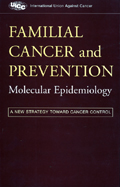Familial Cancer and Prevention Molecular Epidemiology: A New Strategy Toward Cancer Control
encontrar mi
Editors: Joji Utsunomiya, John J. Mulvihill, Walter Weber |
This book was inspired by the UICC (International Union Against Cancer) Symposium on Familial Cancer and Prevention, held in Kobe, Japan in 1997. Health specialists, representing many different specialties, came from all over the world to discuss the latest research in their fight against cancer. The focus of the symposium was the new weapon in treating and perhaps preventing cancer: knowledge of a person's family history and genetics. This book, written by many contributors, summarizes that effort.
The book is divided into five sections. In the first section, entitled "Overviews," several contributors describe what they feel the focus of the symposium is. This is best summarized by Walter Weber, who states: "The aims of the UICC Familial Cancer and Prevention Project are to promote the use of the family history for cancer control by sharing information; examining controllable causative factors; encouraging genetic-epidemiologic; preventive, and therapeutic research; and discussing ethical, legal, economic, and psychosocial aspects."
The second section is entitled "General Strategies and Experience," and is subdivided into discussions of logistics and counseling issues. The articles pertaining to logistics argue the importance of setting up an international standard questionnaire for doctors to use with their patients, hence facilitating the ability to collect worldwide data. The contributors discuss the development of software known as Progeny to aid in the data collection. They also provide several examples where this familial data collection is already in use, such as The National Neurofibromatosis Foundation in the United States, and the Swiss medical system. The articles pertaining to the counseling issues discuss ethical questions such as the right to know, patient confidentiality, etc.
The third section is by far the largest, and discusses specific familial cancers, such as endocrine and breast cancer, and many more. These articles cover the latest findings in mostly clinical, but also molecular research. They even touch on prevention issues (ideas such as diet, aspirin use, and calcium intake are discussed).
The last two sections are quite short. Section four is entitled "Workshop Reports," and briefly summarizes the entire symposium's presenting speakers. The fifth section, entitled "Poster Sessions," provides the titles and authors of the presenting posters.
This book is valuable to anyone interested in the use of genetics and epidemiology in the fight against cancer. It is not intended for the layperson, as it is very technically and medically oriented. It compiles much valuable research, and would be of value to anyone in the cancer field, whether it is in a research or clinical capacity.


